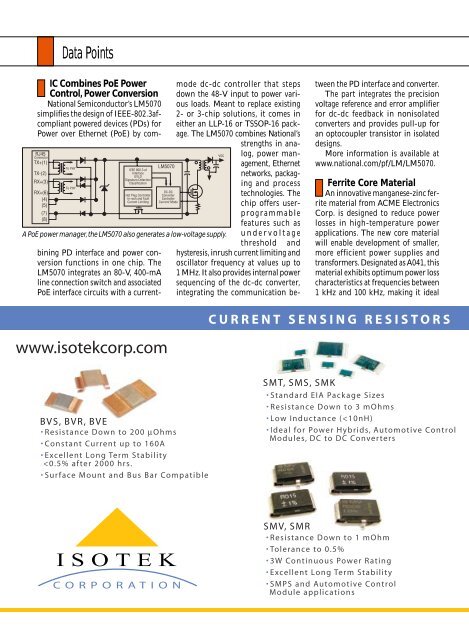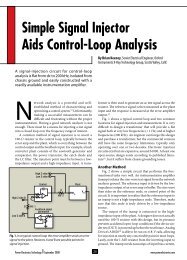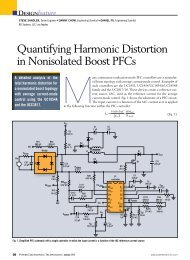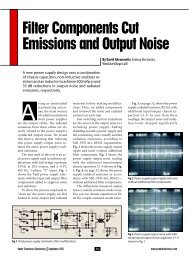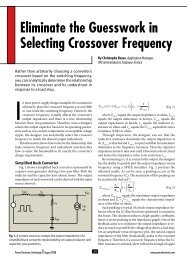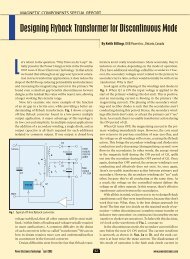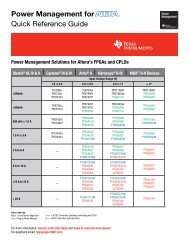Data Points - Power Electronics
Data Points - Power Electronics
Data Points - Power Electronics
You also want an ePaper? Increase the reach of your titles
YUMPU automatically turns print PDFs into web optimized ePapers that Google loves.
RJ45<br />
Connector<br />
TX+(1)<br />
TX-(2)<br />
RX+(3)<br />
RX+(6)<br />
(4)<br />
(5)<br />
(7)<br />
(8)<br />
<strong>Data</strong> <strong>Points</strong><br />
IC Combines PoE <strong>Power</strong><br />
Control, <strong>Power</strong> Conversion<br />
National Semiconductor’s LM5070<br />
simplifies the design of IEEE-802.3afcompliant<br />
powered devices (PDs) for<br />
<strong>Power</strong> over Ethernet (PoE) by com-<br />
To PHY<br />
To PHY<br />
IEEE 802.3 af<br />
Interface<br />
UVLO<br />
Signature Detection<br />
Classification<br />
Hot Plug Controller<br />
In-rush and Fault<br />
Current Limiting<br />
LM5070<br />
DC-DC<br />
Converter<br />
Controller<br />
Current/ Mode<br />
A PoE power manager, the LM5070 also generates a low-voltage supply.<br />
bining PD interface and power conversion<br />
functions in one chip. The<br />
LM5070 integrates an 80-V, 400-mA<br />
line connection switch and associated<br />
PoE interface circuits with a current-<br />
mode dc-dc controller that steps<br />
down the 48-V input to power various<br />
loads. Meant to replace existing<br />
2- or 3-chip solutions, it comes in<br />
either an LLP-16 or TSSOP-16 package.<br />
The LM5070 combines National’s<br />
strengths in ana-<br />
VOC<br />
log, power management,<br />
Ethernet<br />
networks, packaging<br />
and process<br />
technologies. The<br />
chip offers userprogrammable<br />
features such as<br />
undervoltage<br />
threshold and<br />
hysteresis, inrush current limiting and<br />
oscillator frequency at values up to<br />
1 MHz. It also provides internal power<br />
sequencing of the dc-dc converter,<br />
integrating the communication be-<br />
tween the PD interface and converter.<br />
The part integrates the precision<br />
voltage reference and error amplifier<br />
for dc-dc feedback in nonisolated<br />
converters and provides pull-up for<br />
an optocoupler transistor in isolated<br />
designs.<br />
More information is available at<br />
www.national.com/pf/LM/LM5070.<br />
Ferrite Core Material<br />
An innovative manganese-zinc ferrite<br />
material from ACME <strong>Electronics</strong><br />
Corp. is designed to reduce power<br />
losses in high-temperature power<br />
applications. The new core material<br />
will enable development of smaller,<br />
more efficient power supplies and<br />
transformers. Designated as A041, this<br />
material exhibits optimum power loss<br />
characteristics at frequencies between<br />
1 kHz and 100 kHz, making it ideal<br />
<strong>Power</strong> <strong>Electronics</strong> Technology October 2004 10<br />
www.powerelectronics.com
for LAN filters and pulse transformers<br />
with a dc-bias condition. The<br />
material features a wide working<br />
temperature range of -20°C to 100°C.<br />
A041 ferrite material exhibits an<br />
initial permeability of 4000 ±25% at<br />
100 kHz and 0.1 mT (25°C). In<br />
addition, saturation flux density is<br />
1000A/m between 25°C and 100°C.<br />
The A041 material comes in many<br />
standard and custom shapes, including<br />
popular low-profile geometries.<br />
For more information, visit<br />
www.acmemagusa.com.<br />
Rad-Hard MOSFETs<br />
International Rectifier’s radiationhardened<br />
logic-level MOSFETs offer<br />
a more efficient alternative to the<br />
bipolar transistors typically used<br />
in low-power rad-hard applications.<br />
The IRHLUB7970Z4 p-channel device<br />
and the<br />
IRHLUB770Z4<br />
n-channel<br />
device may be<br />
used in place<br />
of bipolars<br />
such as the<br />
2N2222A and<br />
the 2N2907A.<br />
Compared to<br />
the bipolars,<br />
the MOSFETs<br />
require less<br />
drive power, fewer external components<br />
and faster switching.<br />
Packaged in 3LCC or through-hole<br />
packages, the MOSFETs are compatible<br />
with 3.3-V to 5-V TTL and CMOS<br />
logic, are rated for a 60-V breakdown<br />
voltage, and are radiation characterized<br />
to 300 krad (Si) total dose capability<br />
(TID). The MOSFETs also can<br />
<strong>Data</strong> <strong>Points</strong><br />
Safe operating area of the IRH770Z4 logic-level MOSFET as a function of<br />
single event effects tested with bromine (Br), iodine (I) or gold (Au) ions.<br />
Visit us at <strong>Power</strong> Systems World, Booth #1522<br />
withstand a single event effects, as reflected<br />
in their SEE rating to a linear<br />
energy transfer (LET) of 82 MeV (Au).<br />
For more details, visit www.irf.com.<br />
ACPI Specification Revised<br />
The Advanced Configuration and<br />
<strong>Power</strong> Interface (ACPI) specification<br />
has been revised and may be down-<br />
www.powerelectronics.com 11<br />
<strong>Power</strong> <strong>Electronics</strong> Technology October 2004
<strong>Data</strong> <strong>Points</strong><br />
loaded from the ACPI Web site<br />
(http://acpi.info). Revision 3.0 contains<br />
general configuration enhancements<br />
along with added support for<br />
inter-processor power, performance<br />
and throttling state dependency. The<br />
revision also adds support for<br />
>256 processors, NUMA Distancing,<br />
PCI Express, SATA, and Ambient<br />
Light Sensor and User Presence<br />
device. The thermal model has been<br />
extended beyond processor-centric<br />
support.<br />
P-Channel MOSFET Cuts<br />
R DS(ON) in TSOP<br />
Aimed at battery-powered applications,<br />
the AAT7357 from Advanced<br />
Visit us at <strong>Power</strong>Systems World, Booth #2017<br />
CIRCLE 211 on Reader Service Card or freeproductinfo.net/pet<br />
Analogic Technologies is a 20-V lowthreshold<br />
dual P-channel power<br />
MOSFET that achieves low on-resistance<br />
thanks to a high-density<br />
TrenchDMOS process. Housed in a<br />
3-mm × 2.85-mm TSOPJW-8 package,<br />
the transistor specifies a typical<br />
on-resistance (R DS(ON) ) of 30 m at<br />
V GS of -4.5 V. At a V GS of -2.5V, R DS(ON)<br />
is 49 m. Until now, this level of performance<br />
has necessitated use of a<br />
TSSOP-8 package, which occupies<br />
about twice the board area of the<br />
TSOPJW-8.<br />
For more information, visit<br />
www.analogictech.com.<br />
Digital <strong>Power</strong><br />
Management Protocol<br />
Artesyn Technologies and Astec<br />
<strong>Power</strong> have formed a coalition of<br />
power supply and semiconductor<br />
manufacturers to develop and support<br />
a new communications standard<br />
defining an open architecture for<br />
power systems control.<br />
The digital protocol, called “<strong>Power</strong><br />
Management Bus” or PMBus, will<br />
be implemented over the industrystandard<br />
I 2 C serial bus. The founding<br />
group also includes IC vendors—<br />
Intersil, Microchip Technology, Texas<br />
Instruments, Volterra Semiconductor,<br />
Summit Microelectronics and Zilker<br />
Labs.<br />
The PMbus digital protocol addresses<br />
the desire of OEM customers<br />
to have open standards that result<br />
in multi-sourced products. An open<br />
standard could allow OEM customers<br />
to continue to design their power<br />
systems using discrete components<br />
or turnkey converter solutions (dcdc<br />
converter modules). Once the<br />
new protocol is adopted, the OEM<br />
will be able to control all compliant<br />
dc-dc converters using the same<br />
set of commands, without the need<br />
for proprietary silicon or software<br />
interfaces.<br />
For more information, visit<br />
www.artesyn.com or www.astec.com.<br />
PETech<br />
<strong>Power</strong> <strong>Electronics</strong> Technology October 2004 12<br />
www.powerelectronics.com


